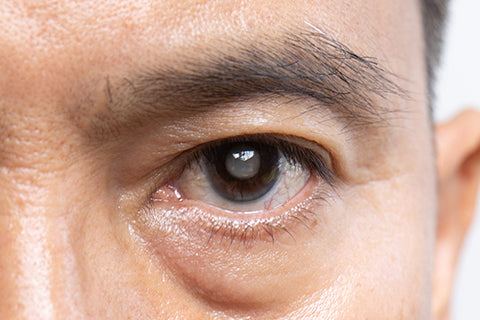Louise Gow, RNIB's head of optometry, low vision and eye health, shares useful information about cataracts and how to make the most of your vision if you are waiting for cataract treatment.
Cataract is where the lens inside your eye has become cloudy. This reduces the amount of light that can get onto the light sensitive layer inside your eye known as the retina. In addition, it can scatter the light causing haze and dazzle. You may find your vision is worse in poor lighting, but also in bright conditions.
Generally, cataracts will be treated when they are affecting your day-to-day activities such as reading, driving, or going out and about.
While you are waiting to have treatment, or if you have to delay for other health reasons, there are several techniques that will help you see as well as possible. We have a handy booklet that goes through these in more detail called Making the Most of your Sight.
These techniques can be grouped into:
- Bigger – making things larger helps you to see them better.
- Brighter – making sure the light you use is optimal (not too bright, not too poor).
- Bolder – consider the colour of the task against its background.
- Use of alternative senses, such as audio or tactile options.
Depending on your vision, your symptoms, and any other health issues (such as arthritis or tremor) you can select from these techniques to get the best from your vision or find the most comfortable way of doing things. For most people it is a mixture. For example, you might choose to use a magnifying glass to read your letters and medicine packets, but use Talking Books when reading for pleasure.
For most people the reduction in vision does not impact their day-to-day life too much before they receive treatment. However, it is important that you ask your optometrist to refer you to a low vision clinic if your vision is causing you difficulties with managing your medicines, day-to-day activities or if you are frightened of falling.
Brighter and bolder: Cataract and haze
Cataracts can cause you to have difficulty seeing in poor light. This is because a cataract is a cloudiness in the lens inside the eye. This cloudiness causes a haze in the vision and makes everything look washed out. This haze makes it particularly difficult to see an object against its background if there isn’t a big difference in colour – this is known as poor contrast sensitivity. An example is a white light switch on a white wall; as they are similar colours, someone with a cataract might not see that there is a light switch there at all.
To help with these symptoms you can use the Bolder strategy out of the Bigger Brighter Bolder vision strategies.
If you also increase the light level (Brighter) you also increase the contrast and make it easier to see. However, it is important to note that the light must be diffused or directed onto the task so that you don’t get dazzled.
Ideal lighting follows these general rules:
- Even light levels through the house so that you don’t have to keep readjusting to the light.
- No open bulbs or spot lights that can create dazzle points and shadows.
- Avoid having glossy surfaces that will reflect light back at you.
- Use additional task lights for close work, under kitchen cabinets or around trip hazards.
- Use daylight bulbs so that the colours are clearer.
We have a dedicated page with more information on improving the lighting in your home.
Improving the colour contrast in your home and in your daily activities can reduce the effect haze has on daily tasks. This can be done with minor simple changes. A few ideas are below:
- Use a black felt tip pen on white or yellow paper when writing lists or letters. This is thicker and bolder and much easier to see than biros or fountain pens.
- Use bright contrast tape around cupboard doors or contrast gel on kitchen appliance dials.
- Have a range of different colour chopping boards so that you can contrast the board with the food you are chopping. For example, white onion against a dark chopping board.
- Think about the colour plate you use when serving food. For example, mashed potato will be lost on a white plate.
- Consider using an eReader instead of conventional books as you can adjust the size of the text and the contrast of screen.
- Use high contrast stickers to make your keyboard easier to see.
Cataract and dazzle
When you have advanced cataracts, you may notice that bright sunshine can cause your vision to be worse. This is because the cataract causes a haze in your vision, and when bright light goes into the eye the haze causes the light to scatter and create a ‘white out’ effect. You might also have difficulties in the winter with the low winter sun reflecting on wet roads, or driving at night with dazzle from car headlights.
During the day the best way to control these symptoms is to wear wraparound sunglasses (known as glare shields or eyeshields) – because the sun is above and to the side of us, conventional sunglasses are not sufficient. There are some glare shields that fit over the top of your spectacles so that you can still have your usual vision correction as well as protection from the light.
Choose the colour (usually grey or brown) that feels the most comfortable to you, and whenever possible try it outside to make sure it works in the environment where you get the symptoms. There are several levels of tint ranging from very dark to very light. If you are very sensitive to the light you might want a very dark one outside, but a light tint for use indoors (for example, if shop spot or strip lights cause you problems).
Polarised glare shields should be used with great care as they reduce reflected light, which might cause you to have difficulty seeing slip hazards like water or ice on the pavement.
Brown colours can sometimes make contrast better too, as they take out the blue wavelength light that is more easily scattered in the eye. Our suggestion is that you try both grey and brown and decide for yourself which feels best.
Other ways to control dazzle include:
- Wearing a hat with a brim or a sports visor.
- Using vertical blinds for your windows in rooms you regularly use at home or work that get a lot of sunshine.
- If you are using a computer screen, don’t have it backing up to the window as the light surrounding the screen will cause dazzle, resulting in discomfort and the screen being harder to see.
It is very important that if you suddenly become light sensitive, you seek advice from your eye care professional as it is not usual for cataracts to cause a sudden change in light sensitivity.
It is also important to remember that it is illegal to wear sunglasses when driving at night. Unfortunately, if you are experiencing dazzle when night driving you should stop until your cataracts have been treated. Rule 94 of the Highway code prohibits the use of tinted glasses, lenses or visors at night.
We have a dedicated page with more advice on choosing a glare shield.
Bigger: Cataract and small details
While you are waiting to have your cataract treated you may find it difficult to see small details such as typical book-size print, details on your phone, or medication and food leaflets.
Making things bigger but combining this with brighter and bolder techniques too can make things easier to see.
Some items you can simply get larger versions of, such as using large print books, asking your service providers to send invoices and information in larger print, or by using larger font options on your phone, tablet and computer. You can also get larger button phones if you use a land line.
Sometimes it isn't possible to get a larger version and then using a magnifying glass with task lighting can be helpful. It is always best to get professional advice on the correct level of magnification to use. Your optometrist should be able to advise you, or you can request an appointment in the low vision clinic at your local hospital (this is only if you will have a long wait before your cataracts are going to be treated).
It is also important to get professional instruction on using a magnifier in order to learn how to use it effectively. Magnifiers of high power can be very difficult to use so you might choose to only use them when reading for short periods of time, such as checking a washing label or cooking instruction. You may choose Talking Books or assistive technology such as mobile phone apps when reading for pleasure.
If you have a smartphone or tablet you can ask the digital advisors at RNIB to talk you through setting up the magnifier options on your device. This can sometimes be better than an optical magnifier as it will give a range of magnification levels which can be useful depending on the task. It can also be used at a typical working distance, so it is easier and more natural to use.
If you are struggling to see the TV, then the best way to magnify this is simply to sit closer and/or get a bigger TV. The screen will not harm your eyes, but sitting closer makes it effectively bigger and easier to see. If this is difficult in your home, you could consider streaming your TV programmes onto a laptop or tablet.
If you are struggling to read your medicine packets, or any other device required to manage your health such as glucose monitors, it is vitally important you let your doctor or practice nurse or pharmacist know so that you can get suitable alternatives to protect you from medicine errors. This is important even if it is for a short time before surgery for your cataracts.
More information




